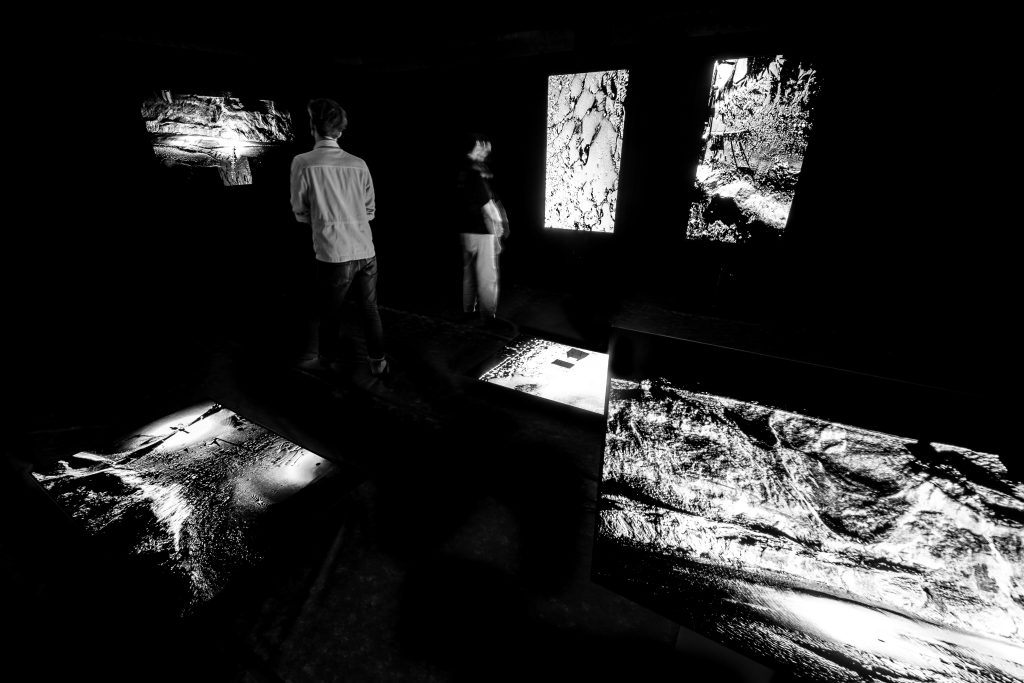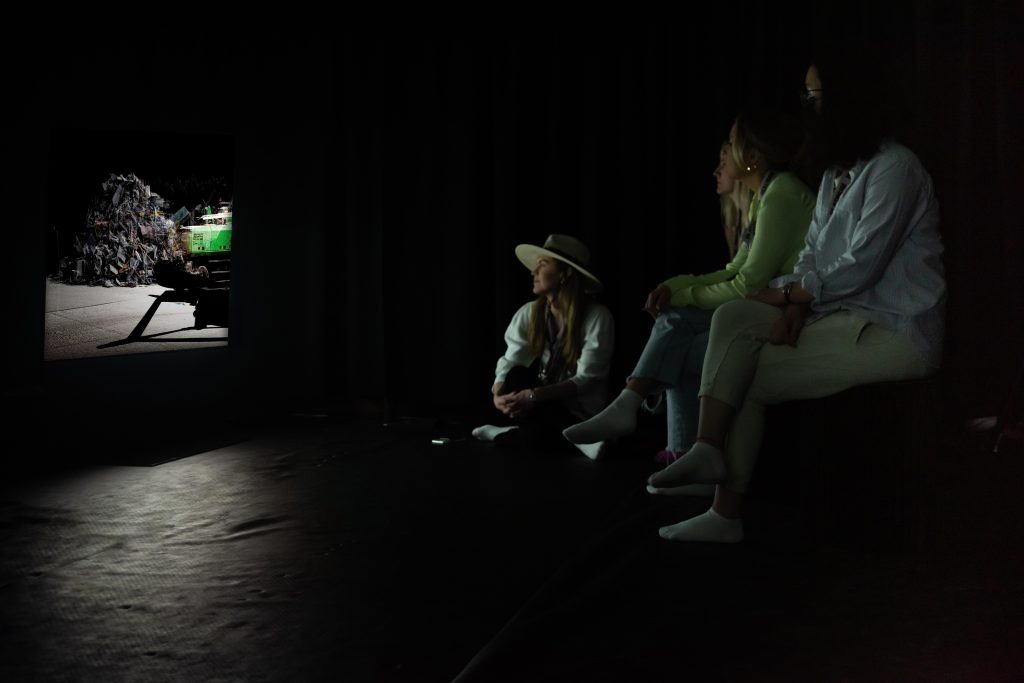ScanLAB Projects’ Astounding “Framerate: Pulse of The Earth” Immersive Installation
Poetic landscape-scale visualizations born from 3D scanning, set to debut in the immersive division of the 79th Venice International Film Festival

Making its world premiere in the Venice Immersive division of the 79th Venice International Film Festival, Framerate: Pulse of The Earth is a spatialized film told across multiple screens in one enveloping installation. Each scene knits together time-lapse footage captured through a LiDAR 3D scanning system by directors William Trossell and Matthew Shaw, the founders of the UK-based creative studio ScanLAB Projects. Framerate: Pulse of the Earth is a powerful, poetic shared experience that tells a story of landscape-scale change. It also happens to be a demonstration of immense technology and built upon real scientific data. With all of this aswirl, ScanLAB’s architectural “machine vision” opens a wormhole into the future of photography and cinematography.
Fundamental to ScanLAB’s work is their expertise in 3D scanning. “We’ve always been really interested in technology and tools,” Trossell tells COOL HUNTING in advance of the Venice installation. “Until you understand a tool at its limits, you don’t really understand that tool. One of the first things we ever organized was a ScanLAB week. We were scanning rainbows and mist and smoke, all right at the edge of what we were told was possible.”
For me, being right at the edge of a tool’s ability, that’s the creative space
“For me, being right at the edge of a tool’s ability, that’s the creative space,” Shaw adds. “That’s where accidents happen and surprises happen. The best use of our kind of skillset is setting up the opportunity for something beautiful to happen but never being exactly sure what that will be.”

Trossell and Shaw are referred to as filmmakers, but also data scientists and sometimes scanning experts. There’s evidence enough, however, that they are defining the future of photography. “I think this comparison stems from some of the similarities that we share with the history of photography and image-making,” Shaw says. “Early photographers in Yosemite were using the vastness of what we call ‘nemesis landscape.’ They were trying to photograph the impossible, like a sky or a waterfall that’s moving too fast for the exposure of an early camera. They were taking cameras into places that were almost impossible to get them to.” ScanLAB embodies this same sense of exploration and the data sets they capture are precise representations down to the millimeter.

There is a point in their practice where spatial data and artistry overlap. ScanLAB orients their data accumulation into stories about climate change and humanity’s provocation. This begins quite early on in their process. “In a practical sense, where you put the scanner is very much as important as where someone would put their camera for a photo—what happens to be in the frame and out of it,” Trossell explains. “The scanner seeing in 360 degrees doesn’t function exactly the same, however. It will follow shadows: if something is in the way, if cannot see beyond it. Mirrors, glass and water all have really interesting reflectivity. In a more theoretical sense, where the focus is and what we choose to highlight is very important. There’s a very delicate balance.”

The filmic project Framerate: Pulse of the Earth is part of ScanLAB’s larger Framerate exploration and data capture. “It isn’t just about getting test data,” Shaw says. “There is a practical conundrum. We ask ourselves ‘What is landscape-scale?’ and ‘What changes with the regularity that we need?’ Then it becomes ‘What story does that mean we are telling?'” With Framerate: Pulse of the Earth, “We are telling a story about landscape-scale change. We ask ourselves, ‘What are the things that are influencing that?’ There’s change that would happen without us—naturally occurring change. There’s change that humans are provoking.”

“There’s also been the longstanding theme running through our work of memory and memory spaces,” Trossell adds. “That got kickstarted by our project Frozen Relic,” which came from a “fortuitous trip to the Arctic.” ScanLAB was invited on the trip to support the science with their technology. Afterward, aware that the landscape was changing, they built an exhibition around pieces of ice that they measured that will never be there again.

In advance of the Venice Film Festival, ScanLAB Projects helped paint a picture of their entire Framerate: Pulse of the Earth multi-screen installation for us. “We spend quite a bit of time trying to get people to pause before they start the experience,” Shaw says. “The purpose of the piece is to try to get people to think on different time scales. The first step toward that is to try to take them out of the time scale they’re in at the moment, which probably has to do with rushing to get to the next ticketed event. When you enter Pulse of the Earth it’s fully blacked-out. Within, there are eight screens that hover in the darkness. They’re arranged in portrait, landscape and horizontally, either on the floor or embedded in the ceiling. These are picture planes like traditional artworks hung in a gallery.” They are also OLED 4K screens so they seem to disappear, allowing the Pulse of the Earth imagery to float in the room.

Each screen acts as a portal into the featured landscape. “It’s the same landscape on all the screens at one time, so you might be entering the beach, or the flower garden or a city. But, all of the screens display a unique perspective of that landscape,” Trossell says. “And all of them are impossible to frame with a traditional camera.”
Though the piece was designed as a 20-minute loop, guests can come and go. During developmental screenings, some people passed through in minutes, others stayed for hours. For the duration of the experience, the layered audio accompaniment was carefully considered. It’s an immersive track by composer Pascal Wyse that responds to the visuals, sets tone and harmonizes the surroundings.

It was very important to the creators that Framerate: Pulse of the Earth be experienced by multiple participants at once. “One of the things we felt in the headset or individually oriented projects we’ve made in the past is that you are missing out on the collective experience of the work and the ability to bear witness,” Shaw says. “Framerate has this generosity of not being one film, but being this film that’s exploded across a room where you can spend a long time with a shot—which would have flashed away in a traditional film—while, in your peripheral vision, the rest of the film carries on and other people are exploring that.” This shared immersion lets participants find their most resonant perspective or the intersection between two moments. They can savor it or share it with friends and strangers.

Ultimately, ScanLAB’s founders have very big picture hopes. “One of the crucial things about Framerate is that it’s a glimpse into the future of a perpetually documented world where we have this phenomenal level of three-dimensional, resolutional versions of the real world that are captured every single day or every minute, intentionally by humans as well as autonomous vehicles, mapping systems, satellites and mobile phones,” Shaw concludes. “We go to a ridiculous length to build a data set or scan something that we think will be regularly scanned. Framerate is about making these first temporal data sets knowing that in five years time Google maps might be there doing this and it will be updated every year or even every day.” Unlike Google or other technology companies capable of harvesting such spatial data, ScanLAB’s work is anchored in artistry and asks questions that could very well lead to societal change.
Images courtesy of ScanLAB Projects












